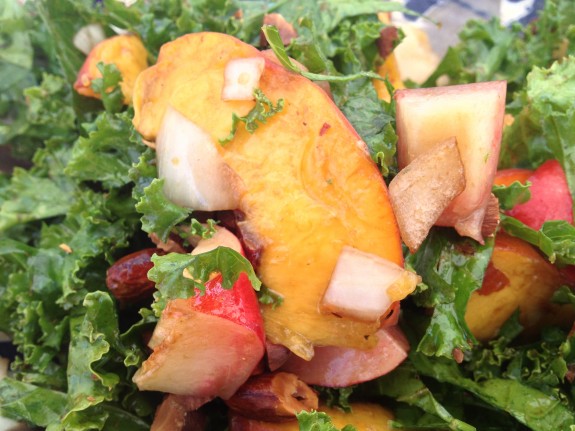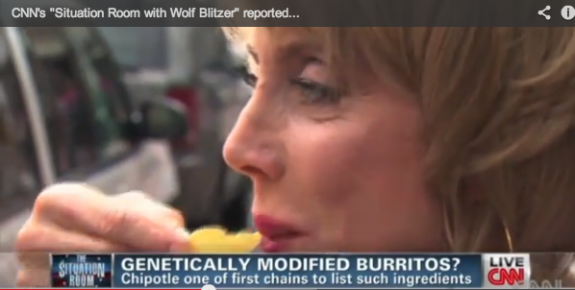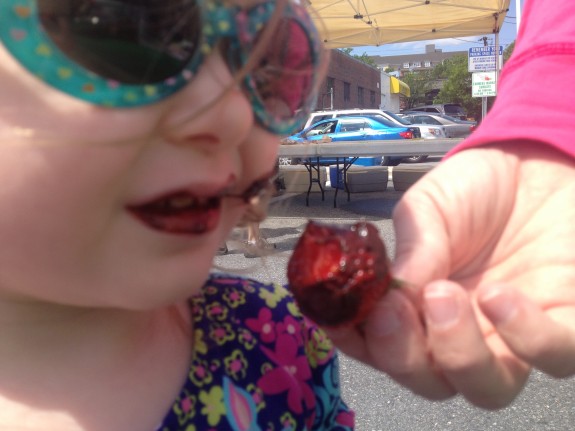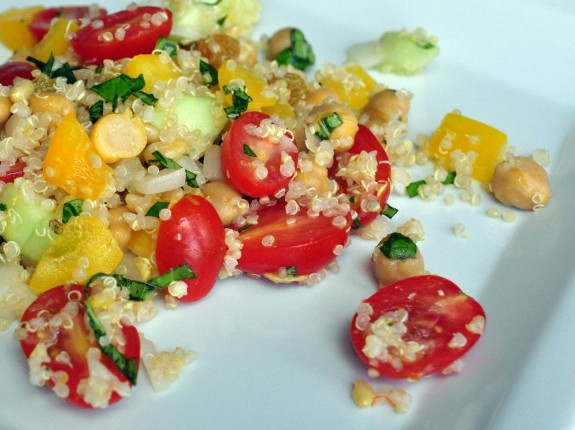Farmers Market Recipe: Fresh Kale & Summer Peach Salad with Toasted Almonds & Balsamic Vinaigrette
- At July 19, 2013
- By Katherine
- In News, Recipes
 0
0
“I don’t normally like kale, but this salad is delicious!” is a comment I hear over and over when I serve this dish. Last year around this time, I was volunteering at an Anacostia Farmers Market. At the time, there was only one produce farmer at the market and all he had the day I was coming was peaches, kale and potatoes! My job at the Farmers Markets is to inspire people to buy the locally grown produce available that day, but what the heck was I going to do with kale, peaches and potatoes? I was stumped! Then I leafed through my own book, Diet Simple: 195 Mental Tricks, Substitutions, Habits & Inspirations, and got inspired by one of Chef Carla Hall’s contributions to my book, her “Hearty Greens Salad with Warm Balsamic Cherry Vinaigrette.” Aha! I can do a variation on the theme, I thought, use peaches, add some crunch with toasted almonds and VOILA! It was a HUGE HIT at the Anacostia Farmers Market. So I’ve included this wonderful recipe in my new book: Diet Simple Farm to Table Recipes (Bookbaby 2013)
Today is the 5th “Katherine’s Market Recipe” of 2013, all of which are designed to be delicious, easy, quick, famiy-friendly, nutritious (heart-healthy & diabetes-friendly), and to highlight produce found at our local farmers markets this week. At your farmers market, you’ll find produce picked at peak ripeness, which means maximum flavor, texture, and nutrition. You’re also helping save the environment when you buy at your farmers market. Here’s how…
Serves 6
Vinaigrette:
3 Tablespoons Extra Virgin Olive Oil
1 Tablespoon Balsamic Vinegar
Salt and Pepper to taste
Salad Ingredients:
6 Handfuls of fresh Kale (or other greens), washed, tough stems removed, and torn into bite-sized pieces
2 Cups Fresh Sliced Summer Peaches and/or any seasonal Berries
2 Ounces toasted slivered Almonds
½ Sweet Onion, peeled and sliced
In a large bowl, add the olive oil, vinegar, salt and pepper. Whisk together. Add the kale, onion, almonds, and peaches and toss together. Serve immediately.
CNN Report Follow-up: Katherine Explains GMOs
- At July 08, 2013
- By Katherine
- In Articles, News
 2
2
Genetically Modified Foods: Part II
Your responses to my recent CNN interview were PASSIONATE – on both sides of the issue – regarding GMO’s health and environmental benefits.
Genetically modified organisms (GMOs) continue to spark passionate debate: Emotions run high regarding studies of the impacts of GMOs on health and the environment.
I was interviewed about GMOs by CNN’s “The Situation Room with Wolf Blitzer” which recently reported that Chipotle and many restaurants and food companies in the United States use GMOs. Though Chipotle is one of the few that voluntarily discloses its ingredients.
It’s important to note that scientists in general regard a GMO food nutritionally equivalent to a non-GMO food.
The U.S. government’s stance
GMOs are not allowed in any food certified as organic by the U.S. Department of Agriculture (USDA). However, in an online food Q&A, the U.S. Food and Drug Administration (FDA) stated that GMOs have been in the U.S. food supply for about 20 years. The agency also stated in a consumer update that “Foods from genetically engineered plants must meet the same requirements, including safety requirements, as foods from traditionally bred plants.” Such foods, the FDA added, “are generally as nutritious as foods from comparable traditionally bred plants… [They] have not been more likely to cause an allergic or toxic reaction than foods from traditionally bred plants.”
Additionally, Michael Jacobson, executive director of the Center for Science in the Public Interest, said there is no safety hazard in using genetically modified soybean oil over conventional soybean oil — a finding the respected organization highlighted recently in its Nutrition Action newsletter.
Hence, the federal government does not require that GMO or non-GMO foods be labeled.
“Food manufacturers may indicate, through voluntary labeling, whether foods have or have not been developed through genetic engineering, provided that such labeling is truthful and not misleading,” the agency stated. “FDA supports voluntary labeling that provides consumers with this information.”
Yes, the GMO debate is still heated and in full swing. There are pros to GM foods —increased yield in staple crops can help to combat world hunger, for example. (Viggy Parr contributed to this report)
Are Genetically Modified Foods Safe?
- At June 19, 2013
- By Katherine
- In Articles, News
 0
0
CNN’s “Situation Room with Wolf Blitzer” reported… that Chipotle Fast Food Restaurants have disclosed (good for them!) they are using some genetically modified foods
Katherine was interviewed recently for the report.
Genetically Modified Organisms: The GMO – in this case a food’s – genetic material has been altered, much like plant breeding, which has been going on for thousands of years. Nutrition and food scientists agree that a GMO food is safe and nutritionally equivalent to a non-GMO food. In fact, some foods have been altered to improve nutrition for undernourished people with great success. An example is Harvest Plus, an organization that has developed iron, zinc and vitamin A fortified seeds for farmers in underdeveloped countries like India.
Sustainable Farming: Farming which has a future, where soil, water, and the environment are protected for future generations.
Local/Seasonal: The movement which promotes eating foods grown locally and in season; when food is picked at peak ripeness for maximum nutrition, flavor, environmental protection, and sustainability. For CNN’s report (and Katherine’s article) on Farmers Markets and how they save your health and the environment…
Omega-6-Fatty Acids, high in soybean oil, compete with Omega-3-Fatty Acids in your body. If omega-6-fatty acid intake is too high in comparison to omega-3’s, this leads to increases in inflammation, a leading risk factor for many diseases including heart disease, cancer, etc. For details…
FREE: Diet Simple Farm-to-Table Spring Cookbook
Celebrate Your Transformation to a Healthier Lifestyle
I’m enthusiastically and gratefully giving you my most cherished spring recipes from my new upcoming Farm-to-Table cookbook FREE, because I appreciate you – my clients and friends – so much. I feel privileged to be part of your life – as your personal guide in your life and health transformation.
Creating a “Diet Simple” Support Community on Facebook
I really enjoy hearing from you, getting regular updates about your health, your family, and your life. So, I’m going to take it to the next level and form an online “Diet Simple” community on Facebook. It will be our online space to support each other, share our cooking adventures, and celebrate our ongoing transitions to a healthier lifestyle and body weight. To encourage you to get in the habit of Facebooking with me, I’m running a contest with prizes I think you’ll love! Follow the instructions below…
Click my book (above), and you’ll find my book to download…
Diet Simple Contest
1. Download and/or print my new Diet Simple Farm-to-Table Spring recipes,
2. Try one of the recipes – or more – and share a picture and your impressions on my “Diet Simple by Katherine Tallmadge” Facebook page,
3. Everyone who posts a comment or picture will be entered into the contest,
4. Refer a friend to do the same, they’ll be entered, and you’ll be entered into the drawing twice.
The Winner: Chooses From the Following Prizes
1. A guided, personal shopping trip to the Farmers Market,
2. Private chef-for-a-night (I cook dinner at your home while you provide the ingredients),
3. A 5-session nutrition counseling program,
4. A talk at your (local Washington, DC) workplace or conference, or
5. Come up with your own idea, and I’ll consider it!
Sieze the New Year!
- At January 05, 2013
- By Katherine
- In Articles, News
 0
0
What are your hopes, dreams and desires for 2013? The new year is a valuable opportunity to improve the quality of your life and happiness. Here’s how to make the best of it…
Now, move mindfully across the threshold into 2012 filled with ideas, possibilities and plans! Analyze people who will continue to be important, ideas to explore, places to spend time, important events and things to carry over from last year to this year.
CREATING A “SENSE OF URGENCY”
An important aspect to making major changes in the world or in your own personal habits is to feel a sense of urgency about your goal. A sense of urgency, according to The Dalai Lama in “The Art of Happiness” – and scholars in this important field of psychological research, can be achieved two ways:
1) Remind yourself of your positive vision for success. For example, visualize yourself at your goal weight, healthy, feeling energetic and confident (see “Dream” in my best-selling book, Diet Simple), and
2) Ponder the negative consequences of not making a particular behavior change (a little fear can be a good thing – but just a little). For instance, in the morning as you’re considering two options: getting out of bed to exercise or sleeping just a little longer. Ask yourself: “Do I want to feel good today? Or do I want to feel crummy today?” Another example, as you’re driving home from work and deciding to grab some carry-out or to go home to eat the healthy meal you’ve already planned. Ask yourself: “Do I want to achieve my weight loss goal (insert positive vision here) or will I accept being the same weight and having the same health problems for another year?” “Do I want to stop taking these darn medications or will I be taking them forever – and even increasing the dosage? What will my doctor say?” “What kind of example am I setting for my children, my spouse? Is this a behavior I can be proud of?” etc. You get the idea…
ACHIEVING INCREASED HAPPINESS
Outlining the consequenses of your actions and acting on your long term goals, as opposed to momentary desires, helps you grow as a person and become a happier person, according to scientific research. It increases your general happiness level because you are making decisions which contribute to your long-term goals.
THE DOWNWARD SPIRAL OF GIVING IN
Usually, when we do something that feels good momentarily, such as giving in and staying in bed for 30 more minutes of sleep in the morning instead of exercising, or grabbing a coffee cake at the coffee shop when we originally just planned on buying coffee, our happiness level may increase (“oooh, this feels yummy!”) – but it’s only a temporary blip of happiness. It goes back to the same level it did before – once the temporary experience wears off – and nothing changes for the better in our lives. We may even become more depressed as we continue to “give-in” to these unfulfilling momentary desires and continue into a downward spiral.
MAKING THE HARDER, BUT MORE SATISFYING CHOICE
If, instead, we say to ourselves, “I’m getting out of bed NOW! I’ll feel terrible if I don’t, and I’ll never achieve my goals,” or “Will stopping to get carry-out change my life for the better? I’d be better off going home and eating something healthy as I want to lose weight, lower my cholesterol, etc,” or “I really don’t need that coffee cake, and I’ll feel terrible after eating it, and will it make me happier at the end of the day?” “Will this increase my happiness for the short term? Or for the long term?” Another more extreme example might be a drug addict relapsing. It feels great momentarily, but the feeling doesn’t last.
When you make a more thoughtful decision, which contributes to your longterm health – physical or psychological – you are more likely to achieve your life’s hopes, dreams and goals, you can actually increase your happiness level, feel happier more often and grow as a person.
WHY IT’S NOT ALWAYS EASY
It is not always easy in our society to make the healthy decision. It’s easier – and the norm, in fact – to be overweight and unhealthy. But, I’m convinced it is possible to be healthy in an unhealthy world with planning, practice, determination, and support (I’m here any time you need me!) – Besides, what’s the alternative?
It takes effort to train your mind to work this way, but this is how we become better people and we advance as a society.
THE RESOLUTION SOLUTION:
HOW TO MAKE YOUR RESOLUTIONS SUCCESSFUL
“Forty to 50 percent of American adults will make New Year’s resolutions for self improvement. Scientific research indicates you are ten times more likely to change by making a New Year’s resolution compared to non-resolvers with the identical goals and comparable motivation to change,” says John C. Norcross, PhD, Professor of Psychology, University of Scranton and coauthor of “Changing for Good.”
Dr. Norcross recommends the following strategies, based on studies tracking successful New Year’s resolvers, and their differences with unsuccessful resolvers:
* Make realistic, attainable goals (See “Tiny Changes, Lasting Results” in Diet Simple’s Introduction),
*Develop a specific action plan (Fill out “Your Personal Goal Worksheet” in Diet Simple),
* Establish genuine confidence that you can keep the resolution despite the occasional slip. Confidence is a potent predictor of who succeeds in the new year! (creating your “sense of urgency” will be useful here – see above)
* Publicly declare your resolution. Public commitments are generally more successful than private decisions,
* Track your progress by recording or charting. Studies show self-monitoring one of the most important behaviors correlated with successful change (see “Write it to Lose It” in Diet Simple),
* Reward your successes (see “Get Sexy Lingerie” or “Kiss Your Spouse” in Diet Simple),
* Arrange your environment to help, rather than hinder, you. Limit exposure to high-risk situations and create reminders for your resolutions (see all of Diet Simple!),
* Expect occasional slips in your resolutions (see “Lighten Up!” in Diet Simple). Studies of successful weight loss maintainers show they experience just as many stressors and slips as weight relapsers; no one’s perfect after all (sorry to disillusion you)! The maintainers pick them self up, dust themselves off, and start all over again!
* Cultivate social support (see all of Diet Simple!). Successful weight loss maintainers are more likely to cultivate support from friends, loved ones, or professionals. It does take a village!
The Battle of the Bulge is Won at the Margins. Sweeping Dietary Overhauls are Impractical and Don’t Work Over Time!
Shrewd, Small, Concrete Changes Which Can be Easily Incorporated into Your Daily Routine Lead to Success!
Music and poetry move me deeply, and in ways I don’t always understand. All we know is after hearing something, we feel so much better. I’ve made some selections that have made a difference for me and hope you enjoy them too.
Vacationing Without the Bulge
- At August 08, 2012
- By Katherine
- In Articles, News
 0
0
In summer, especially August, the pace slows down so much it’s as if the entire country breathes a huge sigh of relief (I know I do). Who cares if business is down a bit? It’s expected this time of year—and besides, it gives you a chance to take a well-deserved break and, if you feel like it, hop on a plane to the islands or drive to a nearby resort.
But vacations offer many opportunities for indulgences that can add up to extra pounds if you’re not careful. I have two philosophies regarding vacation indulgences:
Option A: Enjoy yourself with abandon the whole time, just be prepared to gain a few pounds. If you do choose to go this route, be sure to resume your healthy routine as soon as you get home; if you don’t, you risk those pounds staying with you long after your trip ends.
Option B: Avoid gaining vacation pounds altogether. And it’s not as hard as you think. In fact, many of my clients enjoy themselves even more on vacation when they stay active and eat less heavily.
“My husband and I had a better time when we weren’t just sitting around eating during our annual visit to Greece,” says Vicky, a 40-year-old lawyer. “We made a point of taking walks together and doing more sightseeing than in the past. This gave us more energy and we were surprised at how good it felt!”
I hear this from clients like Vicky regularly. You can actually enjoy your vacation more if you just plan and prioritize a little. Here are some strategies to think about:
• Ask yourself what’s most important to you about the vacation. Is it looking and feeling your best? Feeling energetic? Wearing your most beautiful, form-fitting outfits and bathing suits? Visiting with loved ones? Or is it eating every tempting food in sight?
• Always eat at regularly scheduled intervals. Have a large breakfast and stop for a healthy lunch. Don’t starve yourself during the day so that you irrationally overeat everything in sight whenever you’re around food.
• Set dining priorities. Suppose, for example, you’ve booked four dinners out. You will gain weight if you eat with abandon each time (plan on 1 pound per day). Decide in advance that one of those nights is going to be your “splurge night.” Order anything you want. Enjoy every bite. Savor each and every one of those calories. On the other three nights, order more carefully. You’ll still enjoy the experience of dining out, but you won’t take in more calories than your body can handle.
• Do your homework. Before you go to a restaurant, check out its website and menu. Take note of the courses that look tasty yet healthy. That way, you won’t be as tempted by the sights and smells of fattening options once you get there. Of course, as in any restaurant, the no-brainer healthy selection is a salad-like appetizer, a simple seafood preparation, such as grilled fish, fruit for dessert, and by all means…a glass of wine.
• Stay active. Don’t waste time in a gym: Sightsee! Many of my clients get unbelievable amounts of walking during sightseeing vacations: 20,000 to 25,000 steps per day isn’t unusual (roughly 2,000 steps make up a mile, and the standard steps-per-day goal is 10,000). That’s why you often don’t gain weight on trips to Paris or Rome even when you eat in fabulous restaurants every night. (Without the walking you would, though!) Bring a pedometer to track your steps. If you’re at the beach, swim—or walk along the ocean between chapters of your trashy romance novel.
• Bring a picnic. This is a no-brainer when staying with friends—it’s simply a polite and generous thing to do—or in a rental with a kitchen.
When I stayed at my friend Bob’s place in St. Michaels, Md., recently, I brought one canvas bag of groceries and an insulated bag for perishable items. Knowing most people don’t eat the kind of healthy breakfast I like, I brought two kinds of whole-grain cereals, a bag of roasted slivered almonds, 2 pounds of berries, some fresh-squeezed orange juice, and a gallon of 1 percent milk. Guess what? Everyone enjoyed eating my big breakfast each morning and even carried over the habit once they got home. They felt better for it, and began losing weight to boot.
I also brought vine-ripe tomatoes and a huge pasta salad filled with farm-fresh vegetables, mozzarella, and my delicious basil vinaigrette. It ended up serving four people for lunch one day. Everyone was happy and all this healthy eating gave me room for my weekend splurge: beer floats!
The goal of traveling is to take a vacation from stress and boredom, not from the hard-won healthy practices that you’ve begun to employ—and that make you look and feel so great.
Tabouleh with Chick Peas, Seasonal Vegetables and a Lemony Vinaigrette
- At August 08, 2012
- By Katherine
- In News, Recipes
 0
0
This recipe is always a huge hit. There are many potential variations: Try using Quinoa instead of Bulgur or Soy Beans instead of Chick Peas. Use Tarragon in place of basil. Every vegetable in the recipe – the tomatoes, cucumbers, peppers, sweet onions, garlic, and basil – can be found at the local Farmers Markets at Rose Park on Wednesday or Dupont Circle on Sunday or any other Fresh Farm Market locations. The possibilities are endless! This is a naturally vegan recipe. But for the meat lovers, it’s great with grilled chicken or seafood on the side.
Today is the second of “Katherine’s Weekly Market Recipes,” all of which are designed to be delicious, easy, quick, family-friendly, nutritious (heart-healthy & diabetes-friendly), and to highlight produce found at our local Farmers Markets this week. At your Farmers Market, you’ll find produce picked at peak ripeness, which means maximum flavor, texture and nutrition. You’re also helping save the environment when you buy at your Farmers Market. Here’s how…
By Katherine Tallmadge, M.A., R.D.N., L.D.
Roberto Donna’s White Beans, Kale and Shrimp Salad with Basil Dressing
- At March 16, 2012
- By Katherine
- In Recipes
 0
0
Roberto Donna’s White Beans, Kale and Shrimp Salad with Basil Dressing
excerpted from “Diet Simple”
4 servings
8 oz. Dry Cannellini Beans (or 24 ounces canned, rinsed)
1/2 bunch Kale, cleaned, tough stems removed, chopped
1/ 2 Peeled Onion
1 Celery Stalk
4 Fresh Sage Leaves
1/2 Medium Carrot
8 oz. Shrimp (optional, if using shrimp)
2 Cups White Wine (for cooking the shrimp, if using shrimp)
1 Tbsp Balsamic Vinegar
3 Tbsp Extra Virgin Olive Oil
10 Fresh Basil Leaves
Salt and Pepper to Taste
Optional step if starting with dried beans: Soak the cannellini beans in water for 12 hours; drain and place in a pot of water, add salt and pepper; cover and simmer for 45 minutes.
Optional step if using dried beans: Chop and add the onion, celery and carrot, cooking another ten minutes. Add the finely diced sage to the pot and drain the cooking liquid. Place in a cool location.
If using canned beans: Rinse the beans in a strainer, add to a large bowl. Chop all of the vegetables and the fresh sage leaves and add to the beans. Toss beans, vegetables and sage together.
If using shrimp: Wash and clean the shrimp and poach for three minutes, or until done, in the White Wine.
Add salt and pepper to taste.
Dressing: Finely chop basil and add the balsamic vinegar, salt, pepper and olive oil. Whisk until emulsified.
Presentation: Place a large, clean Kale leaf and 1/4 of the mixture on each plate. Top with 2 oz. of the shrimp and a drizzle of the basil dressing.
As a James Bread Award winning Chef and Restaurateur in Washington, DC, Roberto Donna is committed to introducing others to the real flavors of Italy, which he provides in his seven restaurants. Born in Torino, the Piedmont Region of Italy, Roberto Donna’s fervent mission is the promotion of his authentic Italian cuisine.
Carla Hall’s Hearty Greens Salad with Warm Balsamic Cherry Vinaigrette
- At March 16, 2012
- By Katherine
- In Recipes
 0
0
Carla Hall’s Hearty Greens Salad with Warm Balsamic Cherry Vinaigrette
Excerpted from “Diet Simple”
8 servings
6 c (1 pound) Mixed Hearty Greens (Kale, Rape, Collards, and/or Mustard), washed well, stems removed, rolled and cut thinly (chiffonade)
4 T Canola Oil
2 T Balsamic Vinegar
1 T Dijon Mustard
2 t Honey
Salt and Pepper to taste
½ c Cherries, pitted and halved
¼ Red Onion, sliced thinly
1. In a medium saucepan, heat the oil over medium heat.
2. While the oil is heating, combine the balsamic, mustard and honey in a small bowl. Just before the oil starts to smoke, add the balsamic vinegar and stir to combine. Let the mixture come to a boil, and continue to stir.
3. If it is too thick or too strong with vinegar, add a dash of water. Season with salt and pepper.
4. Add the cherries to the mixture. Toss the greens with just enough vinaigrette to wilt the greens, then drizzle additional vinaigrette around the plate. Garnish the salad with rings of red onion.
Deep Green Leafy Vegetables have the highest antioxidant content of all vegetables. High in fiber, they are rich in minerals, B-vitamins, beta-carotene, and lutein, a compound which may help reduce the risk of age-related macular degeneration (the leading cause of preventable blindness). Absorption of carotenoids, such as lutein, in your body is increased by cooking and by the presence of fat (so cook in a little healthy olive or canola oil!).
Carla Hall, Top Chef finalist, is the owner and chef of Alchemy Caterers, a catering and private chef company in Washington, D.C. She teaches cooking classes at Culinaerie, as well as team building classes at different venues in the metropolitan area.
A Chocolate A Day? Health Benefits of Chocolate De-Mystified
- At February 11, 2012
- By Katherine
- In Articles, News
 6
6
Is it true that a chocolate a day will keep the doctor away? That’s what many chocolate companies would like you to believe in their Valentine’s Day advertisements. While it looks like cocoa has many health benefits, the chocolates you buy from your local stores may impart little of those benefits.
Are you celebrating Valentine’s Day with chocolate? Do you care about chocolate’s health benefits? Tell me about it below in my “Comments” section.
The cacao bean, grown mainly in Latin America, Africa and Asia, is loaded with beneficial compounds. In fact, its early uses, dating back 3,000 years were mainly medicinal. They have ranged from curing fatigue, angina, constipation, dental problems (tartar removal), dysentery, gout, an “overheated” heart, skin eruptions, fevers, and seizures. One doctor in the 1500s found it made people “extraordinarily fat” if used frequently and so it was prescribed for the thin and weak, according to an article in The Journal of Nutrition. It has been highly prized for centuries, which is reflected in its scientific name, Theobroma cacao, meaning “Food of the Gods.”
Eurpoeans discovered cocoa in the 1500s and over the next few centuries, chocolate, which we know and love so well was born. In this century, chocolate (processed cocoa with added fat, milk and sugar) has been enjoyed for its melt-in-your mouth texture and flavor, with its health giving properties largely forgotten by the civilized world, until recently.
In 1997, Harvard professor Norman K. Hollenberg published a landmark epidemiological study focused on cocoa. He found that high blood pressure was a rarity among Panama’s Kuna Indians who also didn’t experience the typical age-related increases. He at first attributed it to genetic protection. But, when the Kunas migrated to Panama City, their blood pressure increased, pointing to an environmental cause. Upon examination, Hollenberg found the Kunas drank large amounts of indigenous, unprocessed cocoa. Subsequent experiments conducted by Hollenberg and others, have found that cocoa, if high in flavanols, the beneficial plant compounds scientists believe impart most of cocoa’s benefits, relaxes the blood vessels, an important protection against hypertension and heart disease.
In the past ten years, cocoa research has intensified, mainly due to the largess of companies like Mars, Inc, most famous for Milky Ways and M&Ms. What’s striking is that candy companies, such as Mars and Nestle’s, have hired respected nutrition scientists and have been largely responsible for the advancement of cocoa research. Mars has collaborated with such institutions as Harvard, the University of California at Davis, and even the United States Department of Agriculture’s Agricultural Research Service. Through their research and others, many interesting discoveries about cocoa’s health benefits have been made.
The flavanols in cocoa help maintain a healthy vascular system, relax blood vessels, they reduce blood clotting – an aspirin-like affect –reduce oxidative damage, and improve blood flow. A study in the American Journal of Clinical Nutrition found cocoa also reduces inflammation. All of which reduces heart disease risk.
There have been some suggestion that flavanols can be used to treat vascular diseases like dementia, pre-eclampsia in pregnant women, and anything related to blood flow. Emerging research is looking into cancer as well.
But what about that chocolate bar in your vending machine? Are there any health benefits there? The answer: probably not much.
Most research about chocolate’s health benefits have used unsweetened cocoa or specially formulated high-flavanol chocolate. Unfortunately, these compounds are rarely in the chocolate we eat in 21st century America. Flavanols impart a bitter taste so they’ve been removed from most popular products to improve their flavor.
Most of the flavanols are in the cocoa beans and the level decreases with each processing step when it goes from the bean, to the cocoa powder and ultimately a finished chocolate product.
Since flavanols and their health benefits are a new discovery, chocolate companies are just beginning to see if there are ways to keep flavanols consistently high, but still have a tasty, popular product.
Katherine’s Chocolate-for-Health Tips
If you’re eating chocolate for health benefits, try my Dark Chocolate-Dipped Fruit recipe, for one, and be very discriminating in your selections.
You’ll get more flavanols, and therefore health benefits, with less processing. The first choice is cocoa, which isn’t Dutch processed – as when cocoa is “Dutch processed with alkali” the flavanols are reduced. Look for chocolate which has the highest percentage of cocoa as possible and to save calories, look for chocolate with lower fat and sugar levels. In general, cocoa is your best first choice. Second choice is a semisweet or bittersweet chocolate with a high cocoa percentage. Some chocolates go as high as 85% cocoa, but legally can be as low as 35%. I recommend no more than an ounce a day, which may be about 110 – 150 calories, depending on the chocolate. Any more than that and you’re probably going to take in too many calories for weight control.
The numbers:
Type of Chocolate Mg Flavonols Calories
1.3 oz Dark Chocolate Bars, Average*: 82 mg 187
1.3 oz Milk Chocolate Bars, Average*: 42 mg 198
1 TBSP Unsweetened Cocoa Powder, Average*: 75 mg 12
*USDA’s Nutrient Data Laboratory
Use this incredible chocolate fondue recipe for berries, sliced pears, bananas, or any favorite fruit!
Katherine’s Hot Cocoa:
1 tsp or 1 Tbsp unsweetened cocoa, to taste
1 tsp or 1 Tbsp honey
1 cup Skim Milk or 1% Milk or Soy Milk
Heat in microwave for 2 – 3 minutes and stir to blend the chocolate.
Using 1 teaspoon of cocoa and sugar, contains approximately 25 mg flavanols and 115 calories (zero saturated fat), depending on the milk used.
Using 1 Tablespoon of cocoa and sugar, contains approximately 75 mg flavanols and 153 calories
Are you interested in chocolate’s health benefits? How much chocolate do you eat? Let me know in my “comments” section below…





![tallmadgecover3[1]](https://katherinetallmadge.com/wp-content/uploads/2013/05/tallmadgecover31-e1369098089483.jpg)













